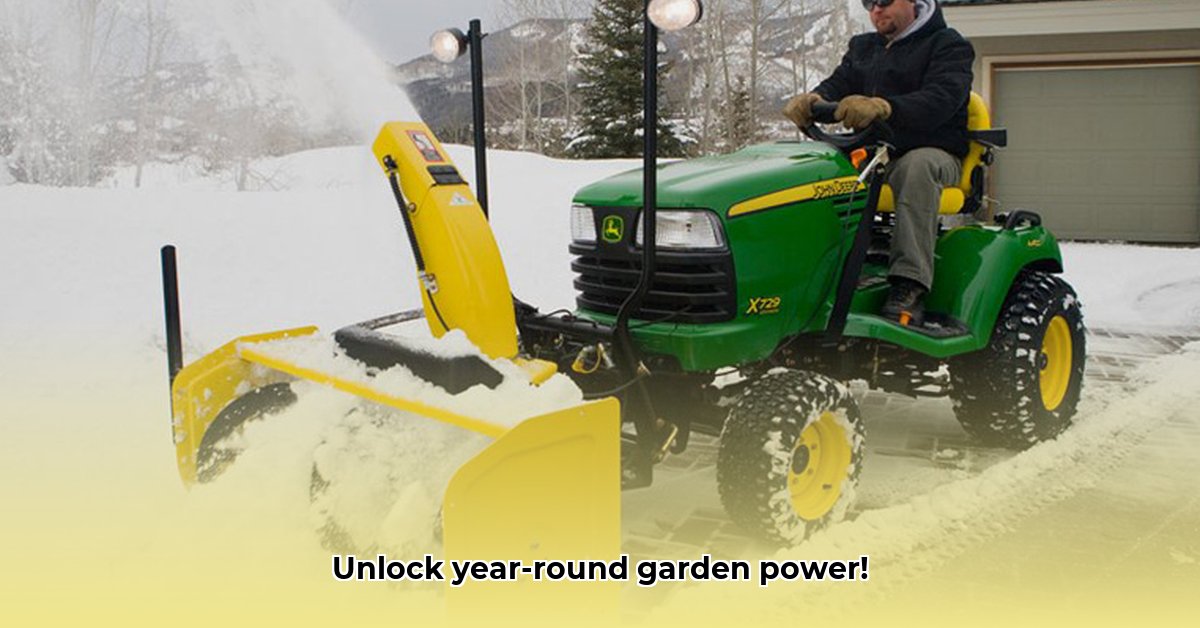
Thinking about conquering those year-round yard chores with ease? Imagine effortlessly mowing your lush lawn in summer, then seamlessly transitioning to clearing snow in winter – all with one powerful machine. A John Deere garden tractor with a plow isn't just about convenience; it's about maximizing your time, boosting efficiency, and making smart financial and environmental choices. This comprehensive guide will empower you to make an informed decision, transforming seasonal challenges into manageable tasks. For more detailed specs, check out this helpful resource.
Assessing Your Needs: Is a Multi-Seasonal Tractor Right for You?
Before investing, honestly assess your property and workload. How many acres need maintenance? What seasonal tasks demand attention—lawn care, leaf removal, snow clearing? The scale of your property dictates the necessary equipment and power. A small suburban lot differs significantly from a sprawling acreage. Let's clarify your needs with a simple checklist:
- Property Size (Acres): Crucial for determining engine size and fuel efficiency. Larger properties demand more horsepower.
- Average Annual Snowfall (Inches): Heavy snowfall necessitates a more powerful snow-removal system.
- Lawn Size & Maintenance Frequency: Frequent mowing of a large lawn demands a robust and efficient tractor.
- Leaf Volume (Estimate): Abundant leaves in the fall require efficient leaf-clearing capabilities.
- Budget (Initial Investment & Ongoing Costs): Consider purchase price, fuel, maintenance, and storage. Long-term cost analysis is vital.
Answering these questions will help you determine if a John Deere garden tractor aligns with your needs and budget. Think of it as a year-round investment that pays back several times over.
Choosing the Right John Deere Tractor: Finding Your Perfect Match
John Deere provides a diverse range of tractors, each designed to address specific property sizes and tasks. Your prior assessment guides your selection. Consider these key factors:
- Engine Size & Horsepower: Higher horsepower tackles larger areas and challenging tasks but may reduce fuel efficiency. Find the ideal balance for your needs. Isn't fuel efficiency a crucial factor for long-term cost savings?
- Fuel Efficiency (Gallons per Hour): Critical for frequent users, impacting operational costs and environmental impact.
- Quik-Knect™ & Quik-Tatch™ Attachments: These innovative systems allow quick attachment changes, maximizing efficiency and minimizing downtime between tasks. How much time will you save switching between mowing and plowing?
- Features & Accessories: Beyond the plow, consider tillers, mowing decks, and other seasonal attachments that enhance versatility.
Thoroughly research various John Deere models, compare specifications, and visit a local dealership for a test drive. Hands-on experience is invaluable before committing to a purchase.
Mastering Attachments: A Step-by-Step Guide to Safe and Efficient Use
Selecting the right attachments is only the first step. Safe and efficient operation is paramount. Here's a step-by-step guide:
- Needs Assessment: Identify attachments for various seasons (plow, mower deck, etc.). Plan for both current and future needs.
- Compatibility Check: Verify attachment compatibility with your chosen John Deere tractor model. Consult your owner's manual.
- Safe Installation: Follow manufacturer instructions meticulously for attachment and detachment. Safety must always be the top priority.
- Practice: Gain experience in a safe environment before tackling large-scale projects. Start small and gradually increase the complexity of your tasks.
Financial Planning: Budgeting for Long-Term Success
Owning a John Deere garden tractor represents a significant investment. A comprehensive budget is essential:
- Initial Purchase Price: The cost of the tractor itself.
- Attachment Costs: Individual costs for each attachment (plow, mower deck, etc.).
- Fuel Consumption: Project fuel costs based on anticipated usage.
- Maintenance & Repairs: Allocate funds for routine maintenance and potential repairs.
- Storage: Factor in the cost of secure storage for the tractor and attachments.
Explore financing options through John Deere Financial or other lenders to manage the initial cost effectively. Compare the long-term cost of tractor ownership versus consistently hiring external services.
Maintenance & Troubleshooting: Ensuring Peak Performance
Regular maintenance is critical for maximizing your tractor's lifespan and avoiding costly repairs. Essential steps include:
- Fluid Checks: Regularly check oil, coolant, and other vital fluids.
- Cleaning & Lubrication: Keep moving parts clean and lubricated to prevent wear and tear.
- Proper Storage: Store the tractor and attachments in a dry, sheltered area when not in use.
- Consult the Owner's Manual: Your manual is a valuable resource for troubleshooting and maintaining your tractor's optimal performance.
Environmental Considerations: Sustainable Land Management
Choosing a fuel-efficient John Deere tractor contributes to environmentally conscious land management. Minimize environmental impact by:
- Fuel Efficiency: Select a model with outstanding fuel economy.
- Emissions: Consider the tractor's emission control features.
- Sustainable Practices: Proper maintenance prevents leaks and spills, reducing your environmental footprint.
Conclusion: Maximize Your Land's Potential, Year-Round
Investing in a John Deere garden tractor with a plow offers substantial benefits. Increased efficiency, year-round versatility, and potential long-term cost savings are just some of the advantages. By carefully assessing your needs, selecting the right equipment, and following sound maintenance practices, you can transform seasonal chores into manageable tasks while minimizing your environmental impact. Ready to take control of your property management? Your journey to efficient, sustainable land management starts now.